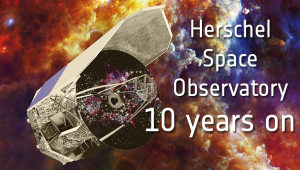
Artist’s Impression of the Herschel Space Observatory. Credit: ESA/Herschel
14th May 2009 marked the the launch of the Herschel Space Observatory. Herschel was a cornerstone mission for ESA, the European Space Agency, with the goal of unveiling the hidden Universe. In this special bonus edition of Pythagorean Astronomy, marking 10 years since Herschel’s launch, we’ll find out how it did this, and what astronomers have uncovered.
Such missions take a lot of planning, and Herschel was decades in the making. But they also far outlive the operational lifetime of the spacecraft itself. Herschel’s liquid helium coolant ran out on 29th April 2013, and the spacecraft was switched off shortly afterwards. With 25,000 observations in the bag, and having imaged around 10% of the sky, scientific discoveries are still being made with data from Herschel.
But what have we learned from Herschel, and what is there still to learn? We’ve had a lot of involvement in Herschel here in Cardiff University, from the design and build of the scientific instruments to the analysis of its data. What better people to ask than those that helped run the mission, and who are using its data to continue to make scientific discoveries a decade on from its launch?
Chris, who was the UK Herschel Outreach Officer, speaks with Cardiff-based colleagues Professor Matt Griffin, lead scientist on the SPIRE instrument onboard Herschel, cosmic dust investigator Prof Haley Gomez, galaxy hunter Dr Mattia Negrello, and star former Dr Sarah Ragan.





